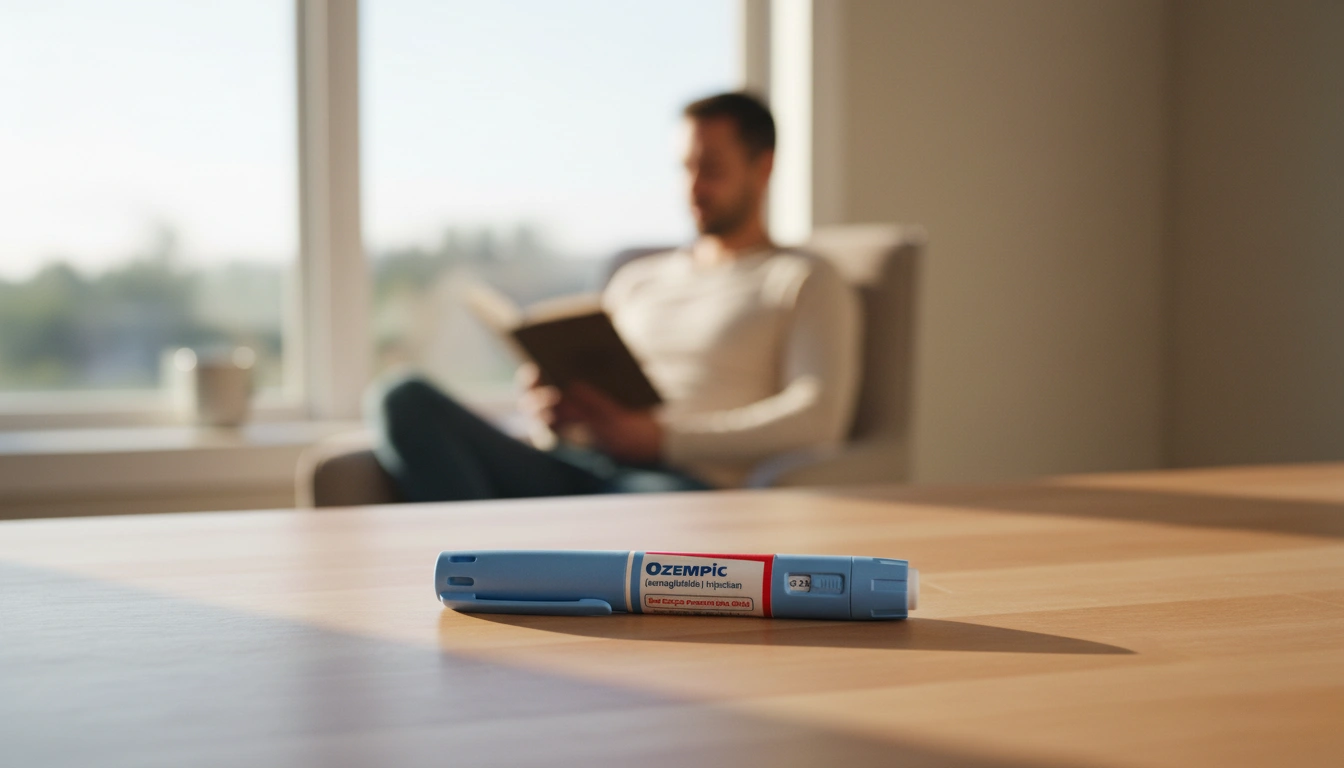Understanding Ozempic Dosing: Can You Take 3 mg of Ozempic?

Many individuals navigating the complexities of weight management and type 2 diabetes often encounter a myriad of questions regarding their prescribed medications. One such query that frequently arises, reflecting a natural desire for faster results or a deeper understanding of treatment limits, is whether it’s possible or safe to take 3 mg of Ozempic. This question isn’t just about a number; it touches upon the fundamental principles of medication safety, efficacy, and the personalized nature of health journeys.
At TrimRx, we understand that every individual’s path to wellness is unique, and informed decisions are paramount. Our journey began with a shared vision to help individuals embrace healthier lifestyles by merging cutting-edge telehealth innovations with effective weight loss solutions. We believe that sustainable weight loss should be achieved through science, empathy, and a transparent approach. This commitment drives us to provide clear, accurate, and supportive information.
This comprehensive guide will thoroughly explore the approved dosing guidelines for Ozempic (semaglutide), clarify the scientific reasons behind these recommendations, and address the inherent risks associated with deviating from a prescribed regimen. We will delve into the mechanism of action of GLP-1 receptor agonists, explain why precise dosing is crucial for both safety and effectiveness, and outline what constitutes an overdose. Furthermore, we will highlight the importance of medical supervision in your weight loss journey and showcase how our personalized, medically supervised programs at TrimRx offer a safe, effective, and tailored approach to achieving your health goals. By the end of this article, you will have a clear understanding of Ozempic dosing and the vital role of expert guidance in maximizing treatment benefits while minimizing risks.
The Science Behind Semaglutide: How GLP-1 Agonists Work
To understand the specifics of Ozempic dosing, it’s essential to first grasp how its active ingredient, semaglutide, functions within the body. Semaglutide belongs to a class of medications known as glucagon-like peptide-1 (GLP-1) receptor agonists. These medications mimic the action of a natural hormone, GLP-1, which plays a crucial role in regulating blood sugar and appetite.
When you eat, GLP-1 is released from your intestines. Its primary functions include stimulating insulin release from the pancreas when blood sugar levels are high, inhibiting glucagon release (which raises blood sugar), slowing gastric emptying, and promoting a feeling of fullness. Semaglutide effectively prolongs these beneficial actions. By mimicking GLP-1, semaglutide helps to:
- Improve Glycemic Control: It lowers blood sugar levels in individuals with type 2 diabetes by enhancing insulin secretion in a glucose-dependent manner and reducing glucose production from the liver.
- Reduce Appetite and Promote Satiety: By slowing down how quickly food leaves the stomach and influencing appetite centers in the brain, semaglutide can help reduce overall food intake, leading to weight loss.
This multifaceted mechanism makes semaglutide a powerful tool in managing type 2 diabetes and, at higher doses, for weight management. However, its potency also underscores the critical importance of precise, medically supervised dosing. The body’s intricate hormonal systems are sensitive, and disrupting them without careful guidance can lead to unintended consequences.
Ozempic Dosing Guidelines: The Facts on 3 mg of Ozempic
When considering the question “can you take 3 mg of Ozempic?”, the answer, based on FDA-approved prescribing information, is straightforward: the maximum approved weekly dose for Ozempic (semaglutide injection) for the treatment of type 2 diabetes is 2 mg. There is no approved dosing schedule that includes 3 mg of Ozempic.
Ozempic is specifically approved for:
- Improving blood sugar control in adults with type 2 diabetes, alongside diet and exercise.
- Reducing the risk of major cardiovascular events (like heart attack or stroke) in adults with type 2 diabetes and established cardiovascular disease.
- Reducing the risk of worsening kidney disease and cardiovascular death in adults with type 2 diabetes and chronic kidney disease.
While Ozempic has gained significant attention for its potential benefits in weight loss, it is important to clarify that Ozempic is not FDA-approved for weight loss. However, semaglutide, the same active ingredient, is approved for chronic weight management under a different brand name, Wegovy®, which comes in higher doses, up to a maximum of 2.4 mg once weekly. This distinction is crucial, as the appropriate dosage and indication for these medications are carefully determined through extensive clinical trials.
Why Dosage Matters: Titration and Safety
The standard Ozempic dosing schedule is designed as a gradual titration process, starting with a low dose and slowly increasing it over several weeks. This approach is not arbitrary; it’s a carefully calculated strategy to allow the body to adjust to the medication, minimize potential side effects (especially gastrointestinal issues like nausea, vomiting, and diarrhea), and find the lowest effective dose for each individual.
A typical Ozempic titration schedule for type 2 diabetes management might look like this:
- Initiation Dose: 0.25 mg once weekly for the first four weeks. This initial dose is primarily to help your body adapt and is generally not considered an effective therapeutic dose for long-term blood sugar control.
- First Increase: After four weeks, the dose typically increases to 0.5 mg once weekly.
- Further Increases (if needed): If additional blood sugar control is required after at least four weeks on the 0.5 mg dose, your doctor may increase it to 1 mg once weekly. If further control is still needed after at least four weeks on the 1 mg dose, the dose may be increased to the maximum approved dose of 2 mg once weekly.
For reducing the risk of worsening kidney disease and cardiovascular death in individuals with type 2 diabetes and chronic kidney disease, the recommended maintenance dose is typically 1 mg once per week after an initial titration.
Understanding the Approved Ozempic Doses
Ozempic is available in prefilled, disposable pens that deliver specific doses. These pens are designed to ensure precise measurement and administration. The different pens are formulated to deliver 0.25 mg, 0.5 mg, 1 mg, or 2 mg per injection. There is no pen or method for delivering a 3 mg dose of Ozempic through an approved, commercially available product.
Each pen contains multiple doses, and users select their prescribed dose using a dial. The 2 mg dose is the highest approved for Ozempic. Attempting to administer a 3 mg dose would require combining injections or manipulating the device, actions that are highly discouraged and dangerous.
The Role of Medical Supervision in Dosing
The gradual dose escalation of Ozempic is a medically supervised process. Your healthcare provider carefully monitors your response to the medication, including blood sugar levels and potential side effects, to determine when and if a dose increase is appropriate. This personalized approach ensures that you receive the optimal dosage that provides the desired therapeutic effect while minimizing risks.
Self-adjusting your medication dose, especially attempting to take a dose like 3 mg of Ozempic, bypasses this critical medical oversight. Such actions can lead to serious health complications and undermine the effectiveness and safety of your treatment plan. This is why our approach at TrimRx emphasizes continuous, medically supervised care, ensuring that any adjustments to your treatment plan are made responsibly and in consultation with our medical professionals.
Risks of Exceeding Prescribed Doses
The idea of taking a higher dose of medication than prescribed, such as considering 3 mg of Ozempic, often stems from a desire for quicker or more pronounced results. However, with powerful medications like semaglutide, exceeding the recommended dosage can lead to significant and potentially severe adverse effects, far outweighing any perceived benefits. Our commitment to safety at TrimRx means we educate our clients on these crucial distinctions.
One of the most immediate and serious risks of taking too much Ozempic is hypoglycemia, a severe drop in blood sugar levels. While Ozempic primarily stimulates insulin release when blood sugar is high, an excessive amount of the drug can push blood sugar too low, particularly if you are also taking other diabetes medications like insulin or sulfonylureas. Symptoms of hypoglycemia can include:
- Dizziness, lightheadedness, or confusion
- Headaches
- Shaking or tremors
- Mood changes, irritability
- Nausea and vomiting
- Weakness and fatigue
- Rapid heartbeat
- In severe cases, loss of consciousness, seizures, or even death.
Beyond hypoglycemia, higher doses of semaglutide, even within approved ranges, can intensify common gastrointestinal side effects. An overdose can escalate these to a severe and prolonged degree:
- Severe Nausea, Vomiting, and Diarrhea: These can be debilitating and lead to significant discomfort and dehydration.
- Abdominal Pain: Intense abdominal pain can indicate more serious complications.
- Dehydration: Excessive vomiting and diarrhea can rapidly lead to dehydration, which can strain the kidneys and other organs.
- Pancreatitis: This is a rare but serious inflammation of the pancreas, characterized by severe abdominal pain, often radiating to the back, accompanied by nausea and vomiting. It can require hospitalization and intensive medical care.
- Ileus (Bowel Obstruction): Semaglutide slows gastric emptying, and an overdose can exacerbate this effect to the point where the bowel essentially “goes to sleep,” leading to a functional blockage rather than a physical one. This can cause severe abdominal pain, bloating, and an inability to pass stool or gas.
- Acute Kidney Injury: Dehydration, compounded by severe gastrointestinal symptoms, can put significant stress on the kidneys, potentially leading to acute kidney injury, especially in individuals with pre-existing kidney conditions.
- Other Potential Risks: While less common, reports have included possibilities of gallstones and, in very rare cases, seizures.
Because semaglutide is a long-acting medication with a half-life of about one week, the effects of an overdose can persist for an extended period, requiring prolonged medical observation and treatment, potentially in a hospital setting.
Recognizing Symptoms of Overdose
It is crucial to recognize the signs and symptoms that might indicate an Ozempic overdose. If you or someone you know accidentally takes more than the prescribed dose, even if it’s not a full 3 mg of Ozempic but still an excess, monitor for any of the following:
- Extreme nausea and persistent vomiting
- Severe abdominal pain that doesn’t subside
- Dizziness, lightheadedness, or fainting
- Profuse sweating or clamminess
- Confusion or disorientation
- Rapid or irregular heartbeat
- Inability to pass stool or gas for an extended period
- Signs of dehydration, such as dry mouth, increased thirst, or reduced urination
The Importance of Prompt Medical Attention
If you suspect an Ozempic overdose, or if you experience any severe or concerning symptoms after taking your medication, it is imperative to seek immediate medical attention. Do not wait for symptoms to worsen.
- Contact Emergency Services: For severe symptoms like loss of consciousness, seizures, or extreme pain, call 911 (or your local emergency number) immediately.
- Call Poison Control: For guidance on less severe but concerning symptoms, contact America’s Poison Centers at 1-800-222-1222. They can provide expert advice on the next steps based on the amount of medication taken and the symptoms observed.
- Inform Your Healthcare Provider: Always notify your prescribing doctor about the situation. They can provide specific guidance tailored to your health history and current treatment plan, and adjust future doses as necessary.
At TrimRx, safety is our top priority. We emphasize the importance of adhering strictly to your personalized treatment plan and never self-adjusting medication doses. Our medical team is always available to provide support and address any concerns you may have regarding your medication and its effects. We work with FDA-registered and inspected pharmacies to ensure that the medications shipped are of the highest quality and precisely dosed as prescribed by your medical provider.
Beyond Ozempic: A Broader Look at GLP-1 Medications
While the discussion around “can you take 3 mg of Ozempic” centers on a specific brand and dosage, it’s helpful to understand that semaglutide is part of a larger family of GLP-1 receptor agonists. This class of medications includes various options, each with its own approved indications, dosing schedules, and administration methods.
Beyond Ozempic, other prominent GLP-1 agonists and related medications include:
- Wegovy® (semaglutide): This is the same active ingredient as Ozempic but is specifically FDA-approved for chronic weight management in adults with obesity or who are overweight with at least one weight-related comorbidity. Wegovy is prescribed in higher doses than Ozempic, with a maximum weekly dose of 2.4 mg. This demonstrates that while semaglutide is effective for weight loss, the specific dosage and brand are critical for its approved use.
- Rybelsus® (oral semaglutide): For individuals who prefer not to use injections, Rybelsus offers an oral tablet form of semaglutide. It’s approved for glycemic control in adults with type 2 diabetes. Its dosing is daily, starting at 3 mg and titrating up to 7 mg or 14 mg. This requires a different administration protocol (taken with a small amount of water on an empty stomach) compared to injectable forms.
- Mounjaro® (tirzepatide): Tirzepatide is a newer and distinct medication that acts as both a GLP-1 and a GIP (glucose-dependent insulinotropic polypeptide) receptor agonist. This dual-action mechanism makes it highly effective for improving blood sugar control and promoting significant weight loss in individuals with type 2 diabetes. Mounjaro is administered once weekly via injection, with a titration schedule that can go up to 15 mg.
- Zepbound® (tirzepatide): Like Wegovy is to Ozempic, Zepbound is the brand-name equivalent of tirzepatide specifically FDA-approved for chronic weight management in adults with obesity or those who are overweight with at least one weight-related comorbidity. It follows a similar titration schedule as Mounjaro, reaching a maximum weekly dose of 15 mg.
Each of these medications has distinct prescribing information, including starting doses, titration schedules, and maximum allowable doses. The decision of which medication is most appropriate depends on an individual’s specific health condition, medical history, existing comorbidities (like type 2 diabetes, cardiovascular disease, or chronic kidney disease), treatment goals, and tolerance to potential side effects.
At TrimRx, our personalized weight loss programs offer a range of these clinically proven solutions, including Compounded Semaglutide, Oral Semaglutide, Ozempic®, Compounded Tirzepatide, Oral Tirzepatide, Mounjaro®, Zepbound®, and Wegovy®. Our medical professionals conduct thorough assessments to ensure that the chosen medication aligns perfectly with your individual needs and health profile.
The TrimRx Approach to Safe and Personalized Weight Loss
Understanding the nuances of medication dosing, like the maximum approved for Ozempic, underscores the essential need for expert medical guidance in any weight loss or health management journey. At TrimRx, we stand by the principle that effective and sustainable weight loss is best achieved through a personalized, medically supervised approach.
Our Commitment to Science and Empathy
Our platform reflects our core values: we are empathetic, innovative, trustworthy, supportive, results-oriented, and personalized. We combine advanced medical science with modern technology to deliver compassionate care that respects every individual’s unique journey. We believe in providing solutions rooted in scientific evidence, delivered with genuine understanding and support. Our telehealth model brings this personalized care directly to you, making medically supervised weight loss accessible and convenient.
The Personalized Path with TrimRx: Prescription Solutions
Unlike generic approaches, TrimRx focuses on creating a treatment plan that is tailored precisely to your body, health status, and lifestyle. We acknowledge that medications like Ozempic, or even considering if you can take 3 mg of Ozempic, represent a significant step for many, and our role is to demystify the process and ensure your safety and success.
Navigating Your Options: Semaglutide and Tirzepatide
Our personalized weight loss programs feature a range of clinically proven GLP-1 receptor agonists and dual agonists, including various forms of semaglutide and tirzepatide. These include:
- Compounded Semaglutide: Offered through our network of FDA-registered and inspected pharmacies.
- Oral Semaglutide: Providing a non-injectable option for those who prefer it.
- Ozempic®: The branded injectable semaglutide, FDA-approved for type 2 diabetes with cardiovascular benefits.
- Wegovy®: The branded injectable semaglutide, FDA-approved for chronic weight management.
- Compounded Tirzepatide: Another powerful option, also provided through FDA-registered and inspected pharmacies.
- Oral Tirzepatide: An innovative oral option for tirzepatide.
- Mounjaro®: The branded injectable tirzepatide, FDA-approved for type 2 diabetes with significant weight loss benefits.
- Zepbound®: The branded injectable tirzepatide, FDA-approved for chronic weight management.
When we offer compounded medications, it’s crucial to understand that while these pharmacies are FDA-registered and inspected, compounded medications themselves are not FDA-approved. Branded medications like Ozempic®, Wegovy®, Mounjaro®, and Zepbound® have received full FDA approval for their specified indications. Regardless of the specific medication, our comprehensive service includes everything you need: doctor consultations, the prescribed medication, lab work to monitor your health, unlimited support from our care team, and convenient shipping, all with no hidden fees. We partner with FDA-registered and inspected pharmacies for the shipping of weight loss medications, ensuring that quality and safety standards are met.
The Quiz: Your First Step Towards a Tailored Plan
For any of our prescription medications, the journey begins with a crucial first step: our free assessment quiz. This comprehensive questionnaire gathers essential information about your health history, current medications, lifestyle, and weight loss goals. This allows our medical professionals to determine your eligibility and receive a personalized treatment plan. It’s designed to ensure that the medication prescribed is not only safe but also the most effective choice for your unique circumstances. Take our free assessment quiz today to see if you qualify for our prescription weight loss medications.
Supporting Your Journey: Quick-Access Supplements
We recognize that the weight loss journey is holistic and often benefits from additional support. For those looking for immediate ways to boost their wellness or complement their personalized prescription program, we offer quick-access supplements that do not require a quiz or prescription. These are available for immediate purchase to support overall wellness during the weight loss journey:
- GLP-1 Daily Support: This supplement is designed to naturally support the body’s GLP-1 pathways and provide comprehensive nutritional support for metabolic health.
- Weight Loss Boost: Formulated to enhance energy levels, metabolism, and fat burning, this supplement provides an additional edge in your weight loss efforts.
These supplements are designed to provide foundational support, whether you are considering a prescription pathway or simply looking to enhance your general wellness.
Ensuring Safety and Transparency with TrimRx
At TrimRx, our dedication to your well-being extends to every aspect of our service. The concern over questions like “can you take 3 mg of Ozempic” highlights the trust individuals place in their healthcare providers and platforms. We uphold this trust through unwavering commitment to safety and transparency.
Our rigorous safety protocols ensure that all prescription weight loss medications are provided through FDA-registered and inspected pharmacies. This guarantees that the medications you receive meet stringent quality and safety standards. While we don’t provide actual medical supervision ourselves, we partner with experienced medical professionals who oversee your personalized treatment plan, from initial consultation and lab work to ongoing support and medication adjustments.
Our approach remains consistent regardless of dosage changes. Each adjustment is made under medical supervision, based on your progress and individual needs, ensuring the safest and most effective path forward. We believe in complete transparency, providing a comprehensive service that includes doctor consultations, medication, necessary lab work, unlimited support from our dedicated care team, and shipping directly to your door – all with no hidden fees. Our goal is to make your weight loss journey as seamless, supportive, and successful as possible, empowering you with the knowledge and tools needed for lasting results.
Empowering Your Weight Loss Journey with TrimRx
Navigating the world of weight loss medications can be overwhelming, with questions about dosing and effectiveness often leading to confusion. Our aim is to demystify this process, providing clear, scientifically-backed information and a supportive environment. The answer to “can you take 3 mg of Ozempic” is a definitive no, underscoring the vital importance of adhering to prescribed guidelines and relying on expert medical advice.
Your health journey is a partnership, and at TrimRx, we are committed to being your trusted guide. We understand that achieving sustainable weight loss requires more than just a medication; it requires a comprehensive, personalized plan, continuous support, and a commitment to safety. Our platform is a user-friendly and supportive space where individuals receive personalized, medically supervised care—all designed to make sustainable weight loss attainable and tailored to the individual.
We invite you to explore the possibilities of a healthier, more vibrant life with TrimRx. Take our free assessment quiz today to see if you qualify for a personalized prescription weight loss plan. Discover how our unique blend of innovative telehealth, clinically proven medications (including Compounded Semaglutide, Oral Semaglutide, Ozempic®, Compounded Tirzepatide, Oral Tirzepatide, Mounjaro®, Zepbound®, and Wegovy®), and compassionate care can transform your weight loss journey.
For immediate support for your overall wellness, consider our quick-access supplements:
- Enhance your metabolic health with GLP-1 Daily Support.
- Boost your energy and metabolism with Weight Loss Boost.
Your journey to sustainable weight loss and improved well-being is a collaborative effort, and we are here to support you every step of the way with empathy, expertise, and a commitment to your results.
Frequently Asked Questions (FAQs)
What is the maximum approved dose of Ozempic?
The maximum approved weekly dose for Ozempic (semaglutide injection) for the treatment of type 2 diabetes is 2 mg. This dose is typically reached through a gradual titration process under medical supervision. Higher doses, such as 3 mg of Ozempic, are not approved and can lead to serious health risks.
Why is it dangerous to take more Ozempic than prescribed?
Taking more Ozempic than prescribed, including attempting a dose like 3 mg of Ozempic, can lead to severe side effects such as dangerously low blood sugar (hypoglycemia), intense nausea, vomiting, diarrhea, abdominal pain, and more serious complications like pancreatitis, ileus (bowel obstruction), or acute kidney injury. These effects can be prolonged due to the medication’s long half-life and may require emergency medical attention or hospitalization.
What is the difference between Ozempic and Wegovy?
Both Ozempic and Wegovy contain the same active ingredient, semaglutide. However, they are approved for different indications and come in different maximum dosages. Ozempic is FDA-approved for the treatment of type 2 diabetes and to reduce cardiovascular risk, with a maximum dose of 2 mg weekly. Wegovy is FDA-approved for chronic weight management in adults with obesity or those overweight with at least one weight-related condition, with a maximum dose of 2.4 mg weekly.
How does TrimRx ensure the safe use of weight loss medications?
TrimRx prioritizes safety through a comprehensive, medically supervised approach. Our process includes thorough doctor consultations, required lab work, and the provision of prescription medications exclusively through FDA-registered and inspected pharmacies. Our medical team oversees personalized treatment plans, including careful dose titration, and provides unlimited support. We emphasize strict adherence to prescribed dosages and offer transparent service with no hidden fees, all designed to make sustainable weight loss attainable through science, empathy, and a transparent approach.

Transforming Lives, One Step at a Time
Keep reading
Navigating Your Treatment: How Many Pens in an Ozempic Box and What It Means for Your Health Journey
Curious how many pens in an Ozempic box? Our guide breaks down Ozempic pen strengths, doses, and how TrimRx supports your weight management journey. Click to learn more!
Empowering Your Health: A Comprehensive Guide on How to Use Ozempic Pens Effectively
Learn how to use Ozempic pens safely and effectively with our step-by-step guide. Master preparation, injection, & disposal for your weight management journey. Get expert tips!
Understanding Your Ozempic Pen: How to Tell When It’s Empty
Wondering how do I know when my Ozempic pen is empty? Learn key indicators, the dose counter trick, and proactive tips for consistent dosing.



